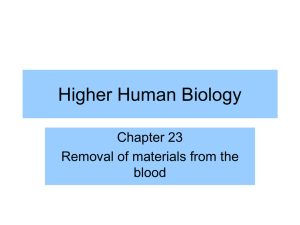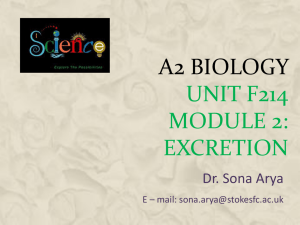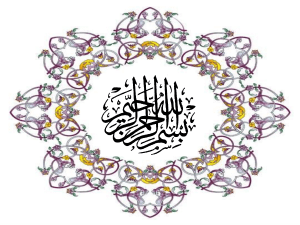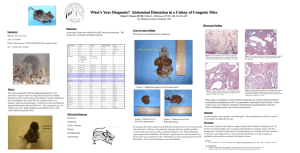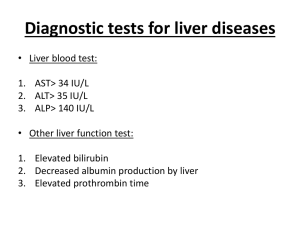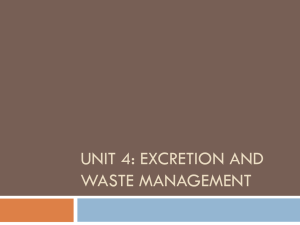F214: Communication, Homeostasis and Energy
advertisement
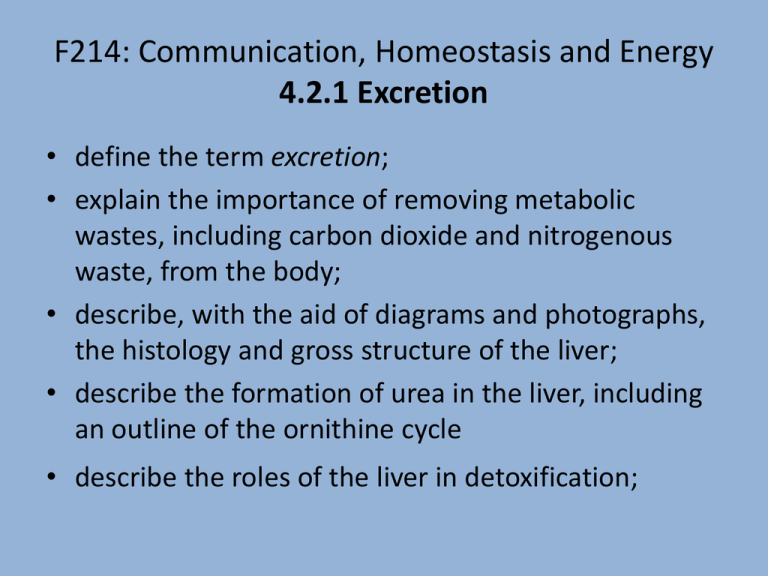
F214: Communication, Homeostasis and Energy 4.2.1 Excretion • define the term excretion; • explain the importance of removing metabolic wastes, including carbon dioxide and nitrogenous waste, from the body; • describe, with the aid of diagrams and photographs, the histology and gross structure of the liver; • describe the formation of urea in the liver, including an outline of the ornithine cycle • describe the roles of the liver in detoxification; Excretion “The removal of metabolic waste (unwanted substances from cell processes) from the body” • Urea from excess amino acids in the liver • Carbon dioxide from respiration Task • Using textbooks, research the importance of the excretion of both carbon dioxide and nitrogenous compounds Q. Why must these substances be removed and where/how are these substances excreted? Why Excrete Nitrogenous Compounds? • • • • • • • • The body can’t store them They have almost as much energy as carbohydrates Transported to liver Toxic amino acid group removed (deamination) Amino group forms ammonia Ammonia converted to urea Urea transported to kidneys for excretion Remaining Keto acid used in respiration or stored Deamination: amino acid + oxygen keto acid + ammonia Urea formation: 2NH3 + CO2 CO(NH2)2 ammonia + carbon dioxide urea + H2O + water Why Excrete Carbon Dioxide? • Excess carbon dioxide is toxic • Carbon dioxide is carried in blood as hydrogencarbonate ions producing hydrogen ions that compete with oxygen for haemoglobin • It combines with haemoglobin to form carbinohaemoglobin with a lower affinity for oxygen than normal haemoglobin • Excess carbon dioxide can cause respiratory acidosis- carbon dioxide dissolves in blood plasma producing carbonic acid with dissociates forming hydrogen ions which lower the pH of blood Carbonic acid production: CO2 + H2O H2CO3 Dissociation of Carbonic acid: H2CO3 H+ + HCO3- Why Excrete Carbon Dioxide? • Hydrogen ions lower the pH and make the blood more acidic • Proteins in the blood act as buffers to resist the pH change, by adding a hydrogen onto their COO (carboxyl group) to become COOH (They can exist as COO in a neutral solution) • The extra hydrogen ions are detected by the respiratory centre in the medulla oblongata of the brain • The brain causes an increase in breathing rate to remove the excess carbon dioxide • If the pH drops below 7.35, the result is slow, difficult breathing, headache, drowsiness, restlessness, tremor, confusion, rapid heart rate and blood pressure changes • This is called respiratory acidosis • Emphysema, chronic bronchitis, asthma and pneumonia, choking or vomiting can also lead to it Where is the liver located? Where is the liver located? Where is the liver? The liver lies just beneath the diaphragm towards the right hand side of the body- it is made up of several lobes • one of the largest organs in the body • 1450cm3 of blood passes through it in one minute • Enormous variety of functions • Uniform structure The Liver 1. Stick in the liver diagram showing the blood vessels 2. Give the function of: • Hepatic artery • Hepatic vein • Hepatic portal vein • Describe the location of the liver in the body The Structure of the Liver Task: Your task is to describe, with the aid of diagrams and photographs, the histology and gross structure of the liver. You must then present your findings to the rest of the class. You can choose how you would like to do this, and what format you would like to use e.g. PowerPoint, information board, poster etc. Task Guide • Decide on the format • Research the liver on the internet using the checklist provided (approx 1-3 hours) • Gather appropriate images (approx 1 hour) • Complete the project including the images and information you have gathered (1-3 hours) • Present your project • You will be assessed by your ability to annotate (label with descriptions) a diagram of the liver Checklist Blood flow to and from the liver including the hepatic portal vein Arrangement of cells inside the liver Structure of liver cells including microvilli The role of Kupffer cells Blood Supply • Blood arrives in two different blood vessels • Hepatic artery leads from the aorta and delivers oxygenated blood to the liver • The hepatic portal vein leads from the small intestine and delivers blood rich in absorbed nutrients (like glucose and amino acids from the intestine) and insulin and glucagon from the pancreas • The hepatic portal vein carries about 3 times more blood per minute than the hepatic artery • Blood from the hepatic portal vein has already travelled through a set of capillaries so is at a much lower pressure than blood in the hepatic artery • The hepatic vein carries blood away from the liver to the vena cava which then transports it back to the heart- it returns glucose to circulation and allows amino acids to enter circulation Histology of the Liver • Made up of many lobules • In the centre of each lobule is a branch of the hepatic vein • Between the lobules are branches of the hepatic artery and the hepatic portal veinblood flows from here, through the lobules and into the branch of the hepatic vein • The lobules are made up of many liver cells called hepatocytes arranged in rows that radiate out from the centre like spokes of a wheel • The channels which carry blood between these rows of cells are called sinusoids • Other channels carry bile, which is produced from some of the hepatocytes: these channels are called bile canaliculi Histology of the Liver • The bile flows from the centre of the lobule towards the outside – the opposite direction to the blood flow, where it enters a branch of the bile duct • The rows of hepatocytes are never more than two cells thick, so that each cell is close to the blood in the sinusoids Histology of the Liver • The sinusoids are lined with large, phagocytic macrophages which capture and destroy bacteria entering the liver via the hepatic portal vein from the intestine • These cells are sometimes called kupffer cells. • They are very efficient- if a bacterium comes into contact with the membrane of a kupffer cell, it is taken into the cell by phagocytosis within 0.01 second!! F214: Communication, Homeostasis and Energy 4.2.1 Excretion • define the term excretion; • explain the importance of removing metabolic wastes, including carbon dioxide and nitrogenous waste, from the body; • describe, with the aid of diagrams and photographs, the histology and gross structure of the liver; • describe the formation of urea in the liver, including an outline of the ornithine cycle • describe the roles of the liver in detoxification; F214: Communication, Homeostasis and Energy 4.2.1 Excretion • define the term excretion; • explain the importance of removing metabolic wastes, including carbon dioxide and nitrogenous waste, from the body; • describe, with the aid of diagrams and photographs, the histology and gross structure of the liver; • describe the formation of urea in the liver, including an outline of the ornithine cycle • describe the roles of the liver in detoxification; F214: Communication, Homeostasis and Energy 4.2.1 Excretion • define the term excretion; • explain the importance of removing metabolic wastes, including carbon dioxide and nitrogenous waste, from the body; • describe, with the aid of diagrams and photographs, the histology and gross structure of the liver; • describe the formation of urea in the liver, including an outline of the ornithine cycle • describe the roles of the liver in detoxification; Control of blood glucose, amino acid and lipid levels Synthesis of Fetal red blood cells, bile, plasma proteins and cholesterol Destruction of red blood cells Liver Functions Storage of vitamins A, D, B12, iron and glycogen Breakdown of hormones Detoxification of alcohol and drugs Urea Formation • Excess amino acids cannot be stored as the amine groups are toxic • Therefore it goes through two treatments in the liver: Deamination and The Ornithine Cycle Deamination • Ammonia is produced which is soluble and toxic • Keto acid is produced which enters respiration directly to release energy R NH2 C R COOH H Amino Acid + O2 C COOH + NH3 O Keto Acid Ammonia The Ornithine Cycle (ammonia’s conversion to urea) • Ammonia is combined with carbon dioxide to produce urea • Urea is less soluble and less toxic than ammonia so it can be passed back into the blood to the kidneys • The kidneys filter out the urea from the blood and store it as urine in the bladder 2NH3 + CO2 CO(NH2)2 Ammonia + carbon dioxide urea + + H2O water As you can see above, ammonia and carbon dioxide enter the cycle. ATP is required and Urea is produced. Water is also produced as a by-product. The body can manufacture ornithine, but it is abundant in meat, fish, dairy and eggs Detoxification • Many dangerous substances are broken down by the liver • Some are made harmless, some are excreted into bile • Most of these processes take place in the smooth endoplasmic reticulum in the hepatocytes • Toxins can be made harmless by oxidation, reduction, methylation or combination with another molecule Detoxification • • • • Oxidation: loss of electrons Reduction: gain of electrons Methylation: the addition of a methyl group Combination with another molecule Methylation is the addition of a methyl group Metabolism of Alcohol • Alcoholic drinks contain ethanol C2H5OH • Ethanol molecules are small and lipid soluble so diffuse easily across the plasma membranes and enter cells • Ethanol is a toxic substance and can cause damage to liver cells • The liver avoids damage by breaking down ethanol into harmless substances Metabolism of Alcohol • The enzyme alcohol dehydrogenase converts ethanol into ethanal (acetaldehyde) • The enzyme aldehyde dehydrogenase then converts ethanal (acetaldehyde) into ethanoate (acetate) • This can then be combined with coenzyme A to form Acetyl Coenzyme A, which then enters the Kreb’s cycle and be metabolised to produce ATP • Ethanol is therefore a source of energy for cells Ethanol Ethanal NAD Reduced NAD Ethanoate NAD Acetyl Coenzyme A Reduced NAD • The Hydrogen atoms released are combined with another coenzyme called NAD to form reduced NAD • NAD is also needed to oxidise and break down fatty acids for respiration • If the liver has to detoxify too much alcohol, it does not have enough NAD to deal with the fatty acids, so they are changed back to lipids and are stored in hepatocytes (liver cells), causing the liver to become enlarged- this is called ‘fatty liver’ and can lead to liver cirrhosis. Discuss in pairs... 1. Why must ammonia be converted to urea? 2. Explain why excess amino acids and alcohol should not be secreted? 3. Suggest why the liver cells have large numbers of mitochondria and ribosomes? Write down your responses in pairs and pass it to another pair to look at- do you have the same responses? Discuss in pairs... 1. Why must ammonia be converted to urea? Ammonia is highly soluble and very toxic- urea is less soluble and less toxic 2. Explain why excess amino acids and alcohol should not be secreted? They contain valuable energy that can be used. Amino acids can be converted into others 3. Suggest why the liver cells have large numbers of mitochondria and ribosomes? Mitochondria provide ATP for processes e.g. protein synthesis. Ribosomes manufacture the enzymes needed by liver cells F214: Communication, Homeostasis and Energy 4.2.1 Excretion • define the term excretion; • explain the importance of removing metabolic wastes, including carbon dioxide and nitrogenous waste, from the body; • describe, with the aid of diagrams and photographs, the histology and gross structure of the liver; • describe the formation of urea in the liver, including an outline of the ornithine cycle • describe the roles of the liver in detoxification;
